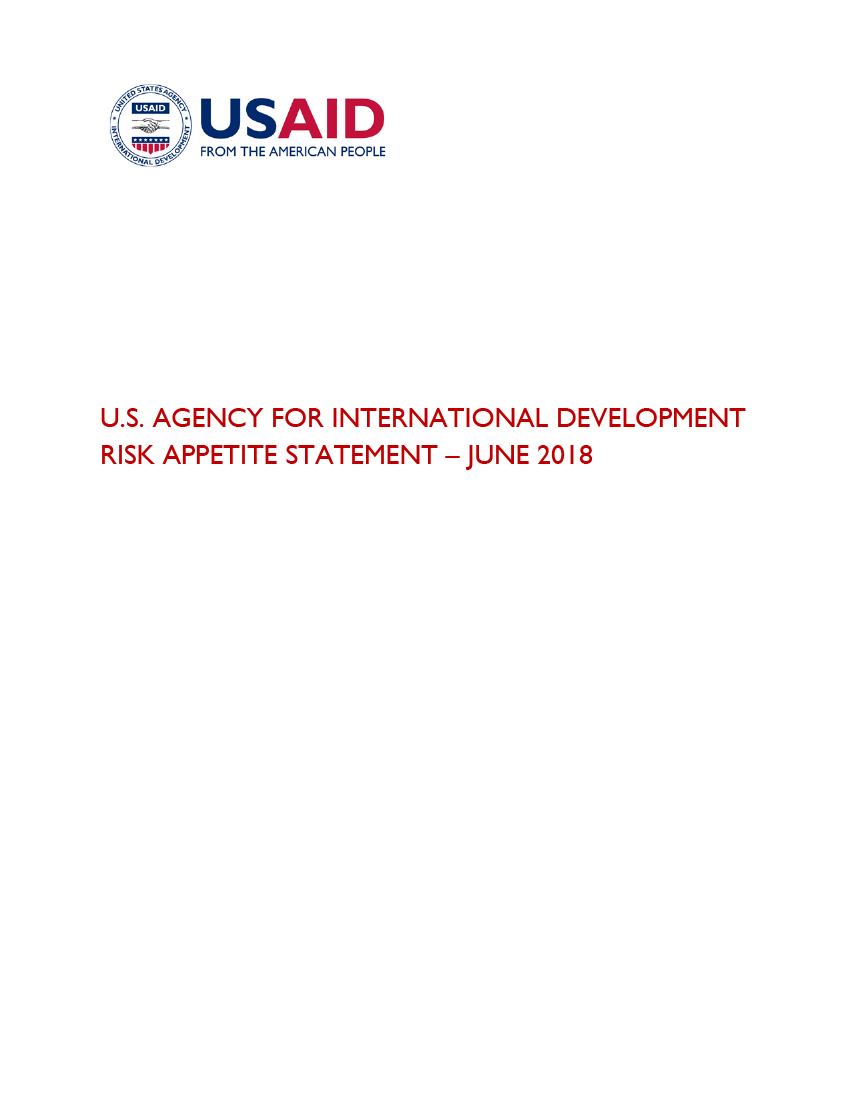USAID is a business-focused development agency focused on results.
We understand that humanitarian assistance is both a gift and an investment on behalf of the American public. It contributes to a future that all of us will share. We are constantly looking for ways to work smarter.
We are committed to transparency and accountability - to serve as a model of open and collaborative government.
Featured Reports and Publications
Each week, USAID features selected reports and publications on this page to highlight the work of our staff and partners around the globe. For more reports on USAID's work, please visit our Reports to Congress page and the Development Experience Clearinghouse.
Risk-Appetite Statement ![]() (pdf - 463k)
(pdf - 463k)
USAID Risk-Appetite Statement - June 2018
USAID staff make decisions about risk and opportunities as part of their day-to-day activities. This Risk-Appetite Statement strengthens an already well developed set of risk management tools and allows staff to take advantage of opportunities to better achieve our mission.
The purpose of this Risk Appetite Statement is to provide U.S. Agency for International Development (USAID) staff with broad-based guidance on the amount and type of risk the Agency is willing to accept – based on an evaluation of opportunities and threats at a corporate level, and in key risk categories – to achieve the Agency’s mission and objectives.
This Statement is a critical component in USAID’s overall effort to achieve effective Enterprise Risk Management (ERM), and the leadership of the Agency will review and update it annually as the ERM program matures and our needs evolve.
Learn more in the USAID Risk-Appetite Statement.
Shared Interest: How USAID Enhances U.S. Economic Growth
The primary objective of United States Government (USG) foreign assistance is to promote U.S. and international security and prosperity by bolstering economic and political stability and self-reliance in developing countries. There is no doubt that investing in global development progress is vital to U.S. national security. However, USG foreign assistance through the U.S. Agency for International Development (USAID) also benefits the U.S. economy and U.S. workers. As one of the most internationally competitive economies in the world, the U.S. is a major exporter of goods and services, and our exports are in demand the world over. As countries get richer, they want to buy more U.S. products and services. By supporting economic growth and self-reliance in developing countries, USAID helps create better, stronger and more resilient markets for U.S. exports.
When countries commit to moving forward, USAID programs can provide the needed capital, technology, ideas, and know-how to assist them. USAID is both from and for the American people.
Learn more in Chief Economist, Dr. Louise Fox’s and Director, Office of Economic Policy, Robyn Broughton’s, Shared Interest Paper.
FY 2018 Agency Financial Report: Empowering Communities on Their Development Journey
From USAID Administrator Mark Green:
Since the day I arrived at USAID, I have described our mission like this: The purpose of foreign assistance should be ending its need to exist. Each of our programs around the world should be aimed at building our partners’ self-reliance, and we should measure our success by how far each investment moves us closer to the day that it is no longer needed.
Because each country must lead its own development journey, USAID is prioritizing tools and reforms that build the local capacity to take on these unique challenges. This dignity is the natural aspiration of not only nations, but communities, families, and individuals. And so I say this not because we want to walk away from our fellow global citizens, but because we believe in them and their potential.
At the same time, we will always stand with the victims of disasters—whether natural or man-made—because that is simply who we are as Americans. And as the world’s leader in humanitarian assistance, we will call on other nations to do their part as well.
As responsible stewards of taxpayer dollars, USAID will work relentlessly to ensure our implementing partners deliver assistance as efficiently and effectively as possible, always looking for ways not only to respond to immediate needs, but also to help other nations build resilience against future shocks and crises.
For USAID to succeed, we must constantly seek to improve. We must always strive to be a little better today than we were yesterday. We are convinced that the structural reforms we have proposed in our Transformation, which are currently pending approval by Congress, will help us become a more responsive and innovative organization. We also continue to pursue a suite of policy and procedural changes that will improve and broaden our partnerships, make our procurement more nimble, and maximize the potential of our workforce in Washington and around the world.
Results and Data
See how our work - on behalf of the American public - spans the globe:

Did You Know?
- More than 3 million lives are saved every year through USAID immunization programs. And thanks to USAID, over 850,000 people have been reached with USAID HIV prevention education, and 40,000 people have been trained to support HIV/AIDS programs in their own countries.
- More than 50 million couples worldwide use family planning as a direct result of USAID's population program.
- With the help of USAID, 21,000 farm families in Honduras have been trained in improved land cultivation practices which have reduced soil erosion by 70,000 tons.
- USAID has targeted some $15 million in technical assistance for the energy sectors of developing countries. U.S. assistance has built a $50 billion annual market for private power. U.S. firms are capturing the largest share of the $50 billion annual market for private power in these markets.
Last updated: December 19, 2018




Comment
Make a general inquiry or suggest an improvement.